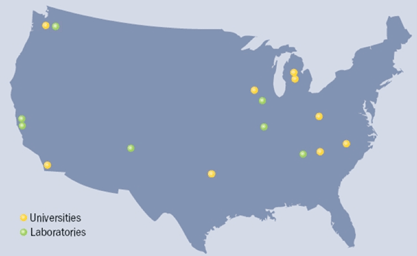Universities and DOE National Laboratories Join Forces to Understand the Nucleus of an Atom
Nuclear physics is the study of the tiny, massive core of an atom, a complex micro-world of particles and forces. Nearly all the mass in the visible universe is locked away in atomic nuclei, as is nearly all the energy. The physics of the nucleus lies at the heart of element formation in exploding stars, as well as sources of energy for public use and national defense. Scientists strive for a comprehensive, unified description of all nuclei, a portrait of the nuclear landscape which incorporates all nuclear properties and forces in one framework. Such a model would allow for more accurate predictions of the nuclear reactions involved in all sorts of processes, from the creation of new elements to the improvement of nuclear reactors.
Around 50 researchers — theoretical physicists, computer scientists, and applied mathematicians — from nine U.S. universities, seven national laboratories, and research institutes across Europe and Japan, have come together in an effort to develop a more complete description of the atomic nucleus and its interactions. Their computational nuclear physics project, known as Universal Energy Density Functional (UNEDF), is led by Ewing Lusk (Argonne National Laboratory) and Witold Nazarewicz (University of Tennessee/Oak Ridge National Laboratory). The project is part of the U.S. Department of Energy's Scientific Discovery through Advanced Computing (SciDAC) program, funded by the Office of Science.

Image credit: SciDAC Review, Winter 2007.
The UNEDF collaboration includes researchers from seven national laboratories and nine U.S. universities: Ames Laboratory, Argonne National Laboratory, Lawrence Berkeley National Laboratory, Lawrence Livermore National Laboratory, Los Alamos National Laboratory, Oak Ridge National Laboratory, Pacific Northwest National Laboratory, Central Michigan University, Iowa State University, Michigan State University, Ohio State University, San Diego State University, the University of North Carolina, Texas A&M-Commerce, the University of Tennessee-Knoxville, and the University of Washington.
A nucleus is one of the most complicated environments in nature because all fundamental forces come into play. The four fundamental forces are called the strong force, electromagnetic force, weak force, and gravity. The constituents of a nucleus are protons and neutrons (collectively referred to as nucleons), which are themselves made of fundamental particles known as quarks and gluons. Each proton or neutron is made of three quarks, which are held together by the exchange of gluons. The quarks and gluons are governed by the strong force; their dynamics are responsible for the strong interaction between nucleons. In addition, both quarks and nucleons interact through the electromagnetic force. This is the familiar force through which particles with the same electric charge repel, and particles with opposite electric charges attract. The protons give each nucleus a net positive charge, so two nuclei will repel each other electromagnetically. Finally, the so-called "weak force" allows some of these particles to transform into others, which is the source of radioactivity. For instance, a neutron can transform into a proton by emitting an electron and a neutrino. While the force of gravity is insignificant inside the nucleus, it determines the existence of neutron stars — gigantic nuclei of stellar proportions. So a complete description of nuclear matter will have to incorporate the physics of all of these forces.
 Image credit: This image was adapted from the original located at SciDAC Review, Winter 2007.
Image credit: This image was adapted from the original located at SciDAC Review, Winter 2007.
A complete theory should incorporate the physics of the nucleus and all of its parts: interactions between the quarks and gluons inside the nucleons; interactions between the protons and neutrons themselves; the dynamics of effective fields represented by proton and neutron densities and currents; and the collective coordinates that describe vibrations, rotations, and other nuclear motion.
An improved description of the nuclear landscape will also require a better understanding of the nuclear "many-body problem" of many protons and neutrons mutually interacting through complex forces. The physics of many-body interactions can become quite complicated, so scientists turn to computers for help with the solutions. Thus, advancing the computational methods for modeling the nucleus is a major focus of this project. "The key objectives are maximal predictive power and well-quantified uncertainties" says Witold (Witek) Nazarewicz, co-director of the project.
One step toward completing a model for the nucleus is to find an "optimal energy density functional" for nuclei, a mathematical tool that can be used to compute the physics of all nuclei in the nuclear landscape. This important goal gives the project its name, Universal Energy Density Functional (UNEDF). Such a functional would allow scientists to compute important properties such as nuclear reaction rates and how much energy can come from a reaction. The tools developed by UNEDF enable predictions of nuclear properties that cannot be measured in nuclear laboratories, and allow the importance of future measurements to be assessed.
Recent achievements of the UNEDF collaboration include the state-of-the art computation of the charge distribution inside Carbon-12, which is a crucial test for theory; computation of short-lived nuclei Fluorine-14 and Fluorine-17, whose properties are important to processes in stars that cause elements to form; description of the "n+t reaction," a type of reaction that is important for understanding how the fuel is assembled in an implosion at the National Ignition Facility; derivation of the nuclear functional from interactions between protons and neutrons; advanced optimization of the nuclear functional; and massive calculations of various nuclear properties, including fission. To this end, the UNEDF scientists used the fastest supercomputers available for research.
The SciDAC team has made great strides towards meeting and in some cases exceeding the initial goals of the project, bringing the power of supercomputers to bear on complex theoretical problems. The computational approach has enabled the team to achieve a number of other important new results. To find out more about the UNEDF highlights, the team invites you to visit http://unedf.org/content/highlights_onepagers.php.
For more information on DOE's Office of Science and its associated laboratories, visit science.energy.gov.
This article was written by Abigail Pillitteri.


